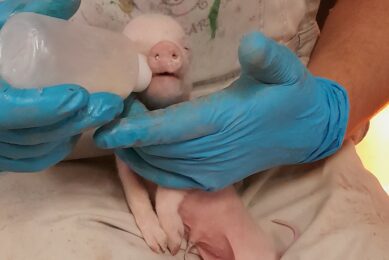Replacing antibiotics: Is it cost efficient?

Alternatives to antibiotics are often seen as too costly. However, in terms of return on investment good antibiotic alternatives can deliver much more than disease management.
By Susanne Kirwan, KEMIN
In a healthy flock, antibiotics deliver no value but antibiotic alternatives can still offer benefits. Antibiotics or other substances with anti-microbial effects are applied regularly in livestock production. While the EU has banned antibiotics applied as growth promoters they are still regularly used for therapeutic reasons. Antibiotic use continues for economic reasons, rather than just treating a group of animals for mortality risks. But even outside farm economics, animal welfare concerns would make treating sick animals a requirement. Within the needed use there are large variations in amounts used according to species and even country.
Costs for antibiotics
The cost for treatment with antibiotics is generally seen as low, around € 0.01-0.02 per bird, particularly in poultry as they can conveniently be given via the water supply. But this only covers a part of the real costs. Often the water lines must be cleaned prior to applying the antibiotic, to avoid detaching biofilm clogging in the drinking lines.
Application also requires labour time, which is dependent on species and husbandry system but even after application, antibiotics may still cause extra costs. It is well known to humans that after antibiotic treatment the intestinal microbiome is often severely disturbed, leading to diarrhoea and overall dysbiosis. While these effects usually resolve without further treatment in humans, in livestock they certainly come with a cost in terms of lost feed efficiency.
Costs for alternatives
Many of the alternatives applied for replacing antibiotic growth promoters (AGPs) can also be used in programmes to reduce the need to treat with antibiotics (Figure 1). Probiotics or active microbials can help modulate the microflora and slow release butyrates can have a positive effect on intestinal integrity. In piglets, slow release acids have shown positive effects on intestinal health from weaning. These are often combined with essential oils for maximum effect. In young animals, which in all species require most antibiotic treatments, supporting the innate immune response can be beneficial to avoid the need of treating with antibiotics. However most of those alternatives are more expensive per ton of feed than just treating with an antibiotic. Unlike antibiotics for an optimal effect it may be required to apply more than one of them further increasing the cost per ton of feed. In the eyes of the farmer and feed miller antibiotic reduction programs therefore mean one thing: A cost without rewards in terms of higher sales prices.
Cost or return on investment?
Antibiotics: Return on investment is easily calculated for antibiotics, cost of treatment over anticipated return due to reduced morbidity and mortality. Treatment in healthy piglets or flocks brings even a negative ROI as the cost for the treatment bring no additional benefit.
Antibiotic alternatives: If chosen well and applied correctly in many cases an antibiotic alternative should bring return on investment of at least 1, meaning that the higher application cost compared to antibiotics should be of no concern.
The main difference arises when comparing the reaction of livestock not acutely sick between antibiotic alternatives and the traditional antibiotic treatments. For example, if a slow-release butyrate (ButiPearl) is applied to a healthy flock of birds, the feed conversion is improved due to the increase of surface for nutrient absorption. If a protected acidifier (Formyl) is given to piglets, the buffering capacity of the feed can be reduced as encapsulated calcium does not have a buffering effect in feed, and diarrhoea risk is reduced. If a probiotic (Clostat) stabilises the intestinal flora of a turkey, the birds will be more resistant to intestinal pathogens of all types, and even if they might still require treatment they will recover from it faster.
When antibiotics are used, the intestinal microbiome becomes unbalanced, taking on a mortgage towards future intestinal health of the animal. Therefore, while they are relatively cheap, reliable, and easy to use, in the longer term they bring economic risks. When good antibiotic alternatives are used, intestinal health is also affected, but in contrast to antibiotics, for the better. Better intestinal health will have a positive impact on feed conversion and uniformity across all species. Return on investment might be best in poor husbandry conditions for intestinal health, however even best practice farms can still benefit.
Wet litter example in poultry
Wet litter in poultry is a constant challenge in broiler production, strongly linked to food pad lesions and welfare concerns for air quality. If antibiotic treatment is used to address the diarrhoea caused by bacterial enteritis, which in turn can cause wet litter, provided the pathogen has not acquired resistance, treatment will be effective. Dry bedding might still have to be added to address the moisture already in the litter, at a cost in terms of material and labour. Alternatives such as probiotics or slow-release butyrates are given via the feed before the wet litter problem arises. They bring some benefits in terms of FCR and uniformity. Additionally, they forestall the expensive and unpleasant task of having to add additional litter. Avoiding wet litter can contribute to the air quality in the poultry house improving conditions for workers and poultry alike. Good intestinal health can prevent respiratory problems by way of drier litter. In a broiler trial, five houses of birds received a probiotic while five were used as control. All other factors and house set-ups were identical. Apart from the expected effects in terms of performance a clear improvement in litter dryness could be achieved (Table 1).
There is a strong drive from consumers and governments to reduce antibiotic in livestock production. Companies are providing an array of products, all offering to replace antibiotics but not all of them can deliver on that promise. It is crucially important to evaluate each additive on its claims. Modes of action should be known, and clear proof should be available that different additives are compatible. Benefits must be visible in farm conditions in production animals, only those that perform there are true alternatives.
 Beheer
Beheer





 WP Admin
WP Admin  Bewerk bericht
Bewerk bericht